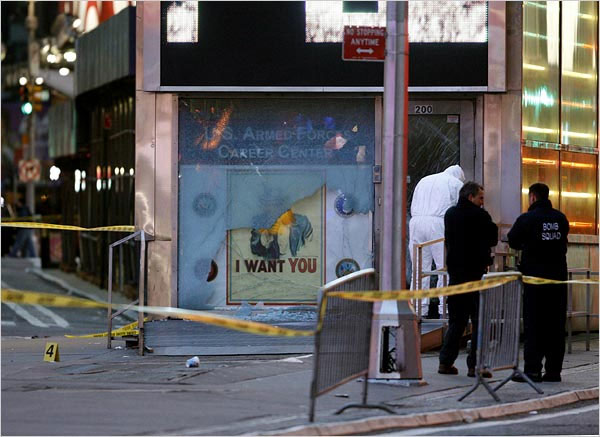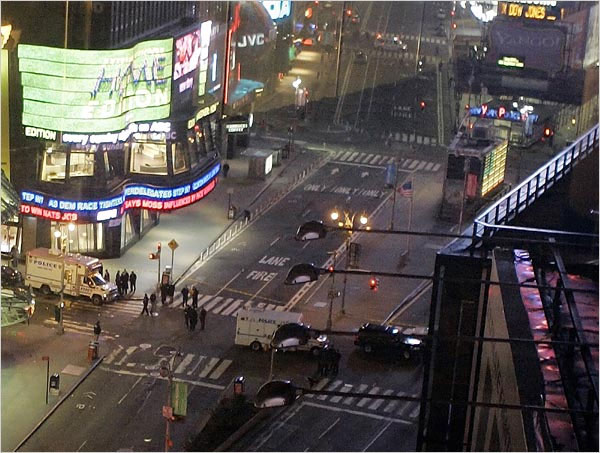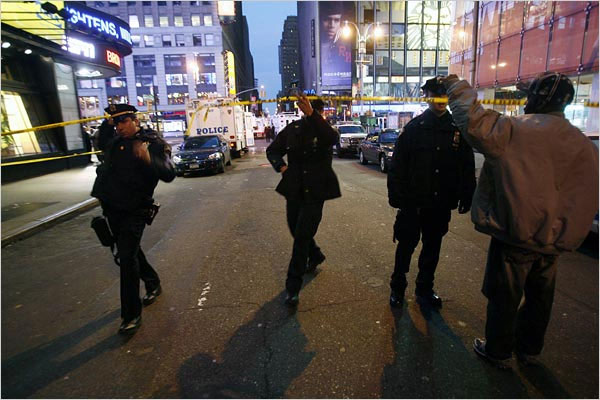
Blast Damages Times Square Recruiting Station
Sewell Chan - NY Times
March 6, 2008
The New York City police issued a statement at 7:33 a.m. describing the source of the explosion as an “improvised explosive device” and putting the time of the blast at 3:43 a.m. Mayor Michael R. Bloomberg was scheduled to give a briefing at the scene at 8:45 a.m., but is running late. The authorities are looking into a possible connection to two earlier bombings at foreign consulates in Manhattan, in 2005 and 2007. Subways and traffic are running normally through Times Square. (See related slide show.)

Photo: Police officers, one of them in a hazardous-materials suit, examined the military recruiting station in Times Square after a small explosion damaged the front of the building early Thursday morning.
(Chip East/ Reuters)
Full Account | New York City police officers and firefighters cordoned off much of Times Square for more than two hours after a small explosion — apparently set off by a manmade device — damaged the front of the Armed Forces Career Center on the traffic island bounded by 43rd and 44th Streets, Seventh Avenue and Broadway around 4 a.m., officials said. No one was injured, and after a temporary interruption, subway service was restored.
Most traffic around Times Square was allowed to pass by 6:45 a.m., after vehicles had been diverted for more than two hours. City officials confirmed that police had initially blocked off the area as a precaution to ensure that there was no secondary device or other threat; the officials emphasized that they did not believe anyone was in danger.
Police officers at the scene said the explosion — which they attributed to an “improved explosive device” — blew a hole through the front door of the recruiting station, which is at the northern end of the structure.
Members of the Joint Terrorism Task Force, the large Police Department and F.B.I. unit that investigates terrorism, were at the scene of the blast, supporting the Police Department’s Bomb Squad, which along with other police detectives likely will take the lead role in investigating the incident, an F.B.I. official said.
The authorities were looking into whether the explosion was connected to two earlier blasts that were similar in method and timing, the official said. At about 3:40 a.m. on Oct. 26, 2007, two dummy hand grenades that had been fashioned into crude bombs exploded outside the Mexican Consulate at 27 East 39th Street in Murray Hill, shattering windows. The building was not occupied and no one was hurt. At 3:55 a.m. on May 5, 2005, two crude but powerful explosive devices detonated outside the British Consulate at 845 Third Avenue in East Midtown, shattering windows and damaging a planter.

Photo: City officials said police had initially blocked off the area as a precaution to ensure that there was no secondary device or other threat; the officials emphasized that they did not believe anyone was in danger. (Richard Drew/AP)
Both attacks were captured on video surveillance. The arc of the device — with its lighted fuse – was visible on the videotape.
In the 2007 attack, a witness told police that a man in his 20s on a bicycle pedaled quickly away and turned south onto Park Avenue, the authorities said at the time. The bicyclist was wearing a hooded gray jacket and his face was partly covered, but the police could not say for certain that he threw the grenades.
In the two earlier incidents, the police said the improvised explosive devices were virtually identical. Both contained explosive powder. Both attacks occurred before dawn when there were few people on the street. And in both cases the devices were thrown against building facades.
At the time of the Mexican consulate attack, Police Commissioner Raymond W. Kelly described the two improvised explosives. He said they were training, or dummy, grenades — perhaps purchased from a novelty shop — that had been hollowed out and stuffed with gunpowder, possibly black powder, and equipped with pyrotechnic fuses. One had a smooth surface, modeled after the “lemon” type used in the Vietnam War, and the other was scored like the rough “pineapple” type used during World War II.
In Washington, a spokeswoman for the United States Department of Homeland Security said it was monitoring and investigating the explosion, Reuters reported. Asked if there was a link to terrorism, the spokeswoman, Laura Keehner, said, “At this time we’re still investigating.”
Capt. Charles V. Jaquillard, the Army Recruiting Command’s company commander for New York City, said in a phone interview that he was informed of the explosion around 5 a.m. “If it were something directed toward the individuals working at that station, then obviously it’s very unfortunate and of great concern, because there’s nothing more important to us than the safety of our troops,” he said.
The explosion briefly disrupted the vital transit node at Times Square, but full subway service had been restored as of 5:39 a.m. A dozen subway lines — the A, C, E, N, Q, R, W, S and Nos. 1, 2, 3 and 7 — run through Times Square. Subway service on those lines — along with the Nos. 4, 5 and 6 lines, which run through Grand Central Terminal — had been suspended at 4:24 a.m., with some lines restored soon after. The recruiting station sits almost directly atop the western terminus of the S, also known as the 42nd Street shuttle, which connects Times Square with Grand Central Terminal.

Photo: For about two hours after the explosion, police officers at the scene said Times Square was closed and turned people and cars back. (Keith Bedford/Reuters)
“I just heard a boom,” said Deon Halliday, 43, a maintenance-security worker at Silverstein Properties at 570 Seventh Avenue who was standing on the avenue, examining the scene, at 6 a.m. “I thought it was a garbage truck. It happened around 4 o’clock. I stayed in the building because I didn’t know what it was. I had to secure the building.” He added, “I came out later and I was looking at the street and no cars are coming by. I saw all the helicopters.”
As the sun came up, at least three helicopters flew overhead, but it was not clear whether the helicopters were operated by the police.
Mohammed Hossain, 39, whose coffee cart, is at the corner of Seventh Avenue and 44th Street, said he heard the explosion before 4 a.m. “I heard a loud noise and I turned around and saw smoke,” he said. “And then the cops were everywhere, within minutes.” Mr. Hossain, who has operated the cart for 15 years, said police asked him to close up until about 7:15.
Just after 6:45 a.m., a handful of law enforcement officers knelt at the foundation of the recruiting station, smashing the carpet of glass shards with long-handled mallets. Two men in hazardous-materials suits stood above them, among more than a dozen investigators from the city’s Police and Fire Departments, the Federal Bureau of Investigation and the Bureau of Alcohol, Tobacco, Firearms and Explosives. Police vans and squad cars ringed the scene, with clusters of detectives on street corners, paging through notebooks and talking on cellphones.
For about two hours after the explosion, police officers at the scene said Times Square was closed, and they turned people and cars back. A large police van and a police vehicle with lights flashing were parked at 42nd Street and Seventh Avenue by 5:30 a.m. Police had cordoned off much of 41st Street, Seventh Avenue and the subway station entrances. Police officers turned pedestrians away, including a woman who was trying to jog through. Workers already in their buildings in the cordoned off area were not being allowed out, police officers at the scene said. Employees of Reuters were being turned back at the police tape, and officers were telling them to take the day off.
“It happened two hours ago,” one officer said at the scene, describing the situation as “very fluid.”
Traffic was diverted for a time even to the west, at Eighth Avenue and 41st Street, where a large police vehicle blocked the avenue and traffic was being diverted through the Port Authority bus terminal. Cars were backed up on Eighth Avenue, with some drivers honking angrily. By 6:30 a.m., traffic was moving more easily up Eighth Avenue.
The recruiting station — the third that has stood on the site since 1946 — has been the site of regular antiwar protests since the start of the Iraq war in 2003, although until today, the only major threat to the station seemed to come from pigeons.
The station reopened in September 1999 after a $1 million redesign by Stephen Cassell and Adam Yarinsky of the Architectural Research Office, a Manhattan-based architecture firm. The 520-square-foot building is decorated with 33-by-14-foot flags rendered in fluorescent lights and a giant, nine-panel television screen. The interior contains space for Army, Navy, Air Force and Marine recruiters and one bathroom.
The previous recruiting station, often known simply as the booth, opened in 1950. Built of stainless steel, with smoked-glass windows, the station was an instantly recognizable landmark of Times Square. “It was the only outpost to house recruiters from all four military branches,” Paul von Zielbauer wrote in The Times in February 1999, when the old station was demolished to make way for the redesigned one. “It was the only station that could reject far more recruits than it enlisted — more than 200 a year signed up — and still claim top honors in recruiting circles. And it was the only recruiting station in the country without a bathroom.”
http://cityroom.blogs.nytimes.com/2008/03/06/police-investigate-explosion-in-times-square/index.html
www.standeyo.com/NEWS/08_Terror/080306.NY.Times.Sq.bomb.html
